PLANES OF FAME: Grumman F-14 TOMCAT
Update: 2020/04/28 by Robert Kysela / CHK6
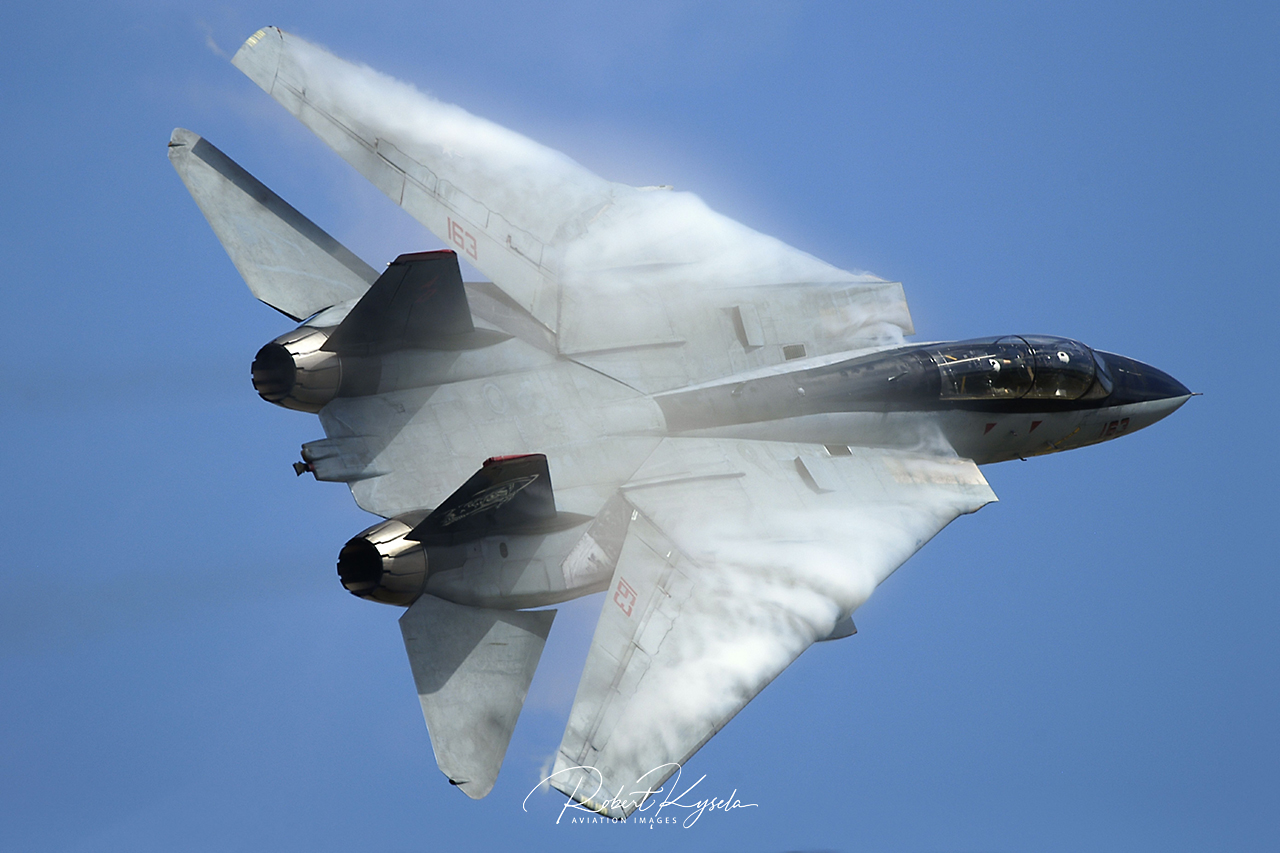
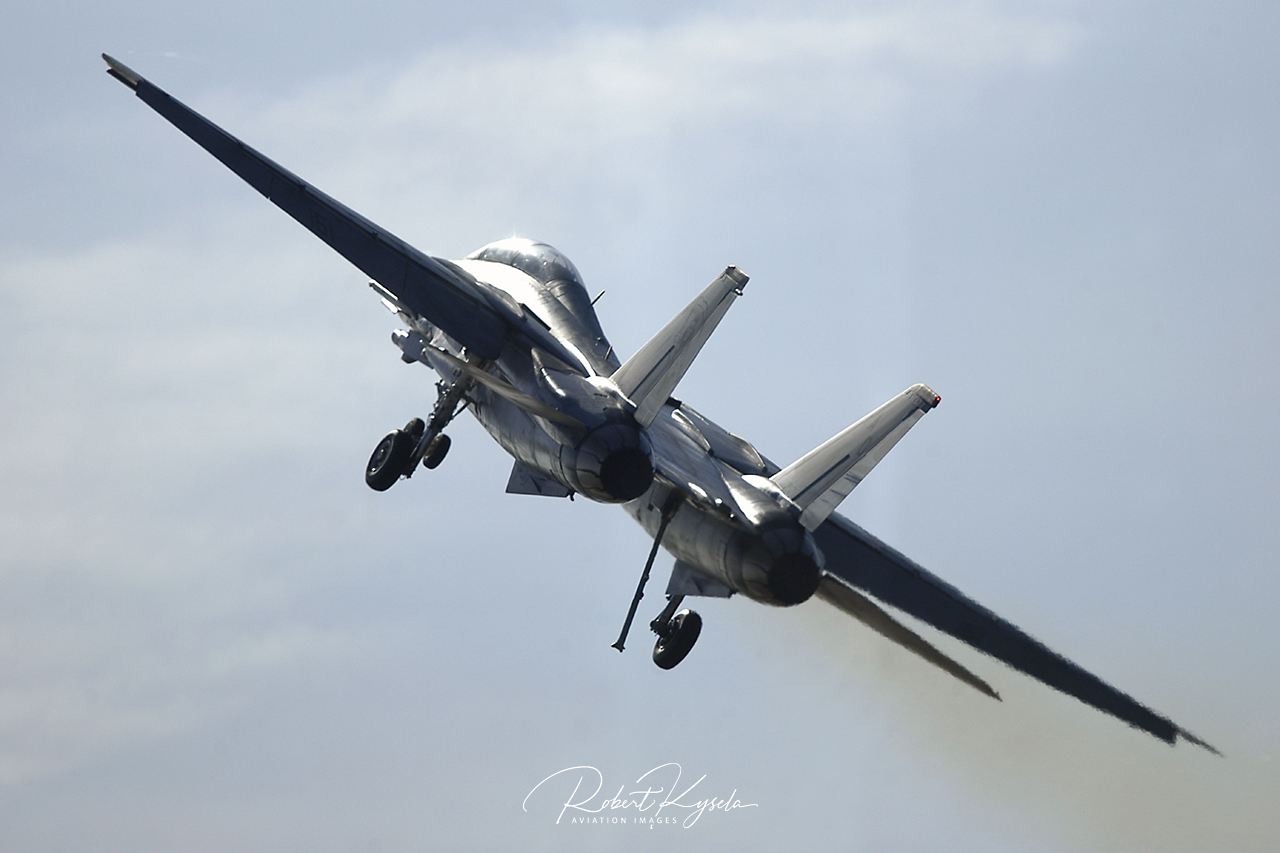
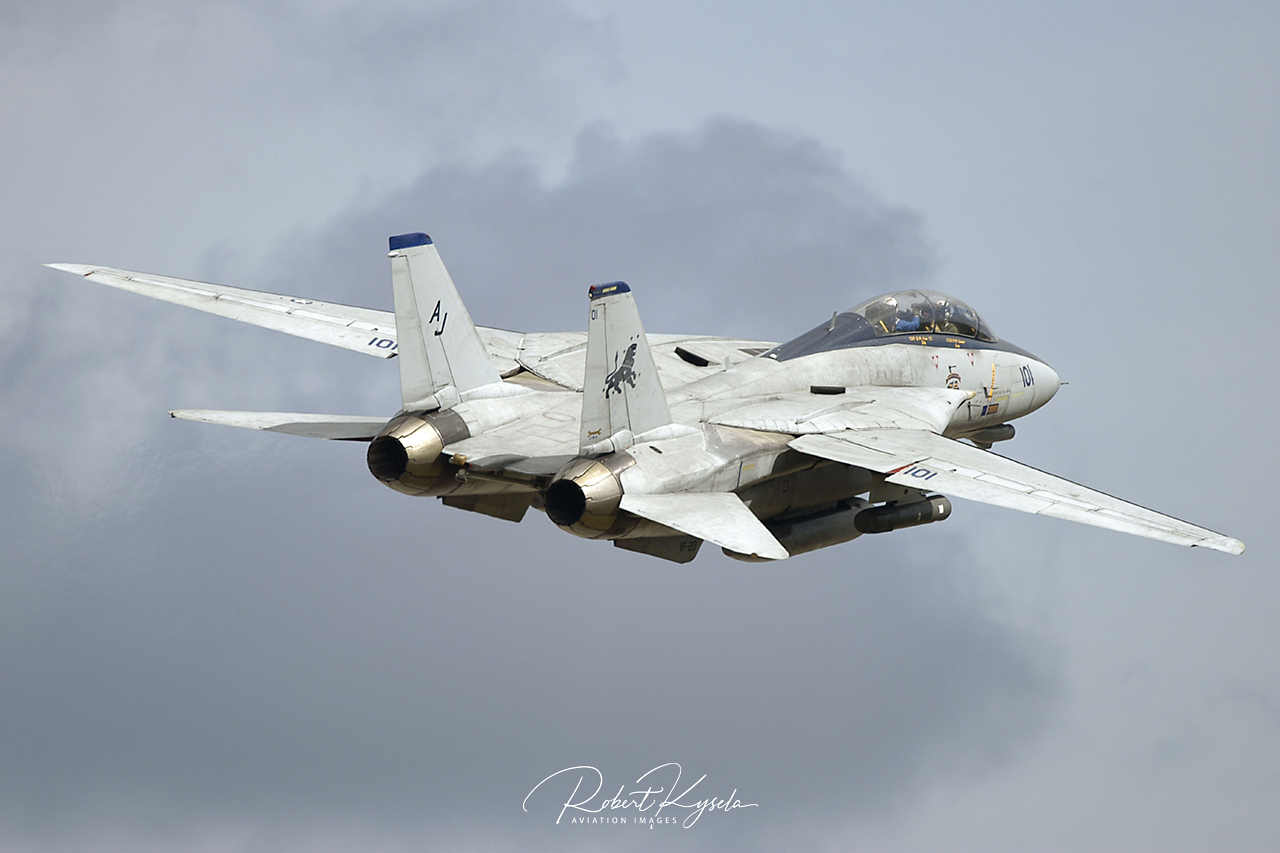
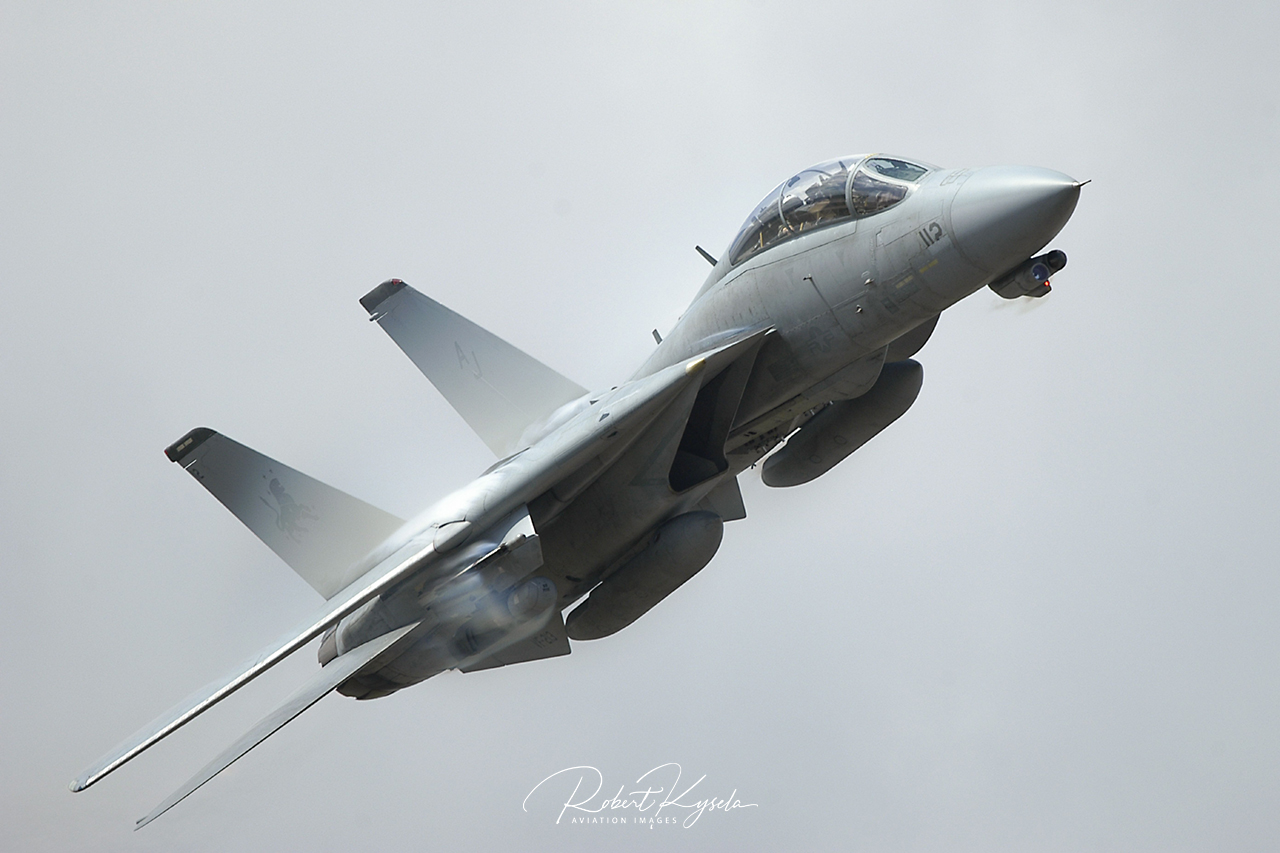
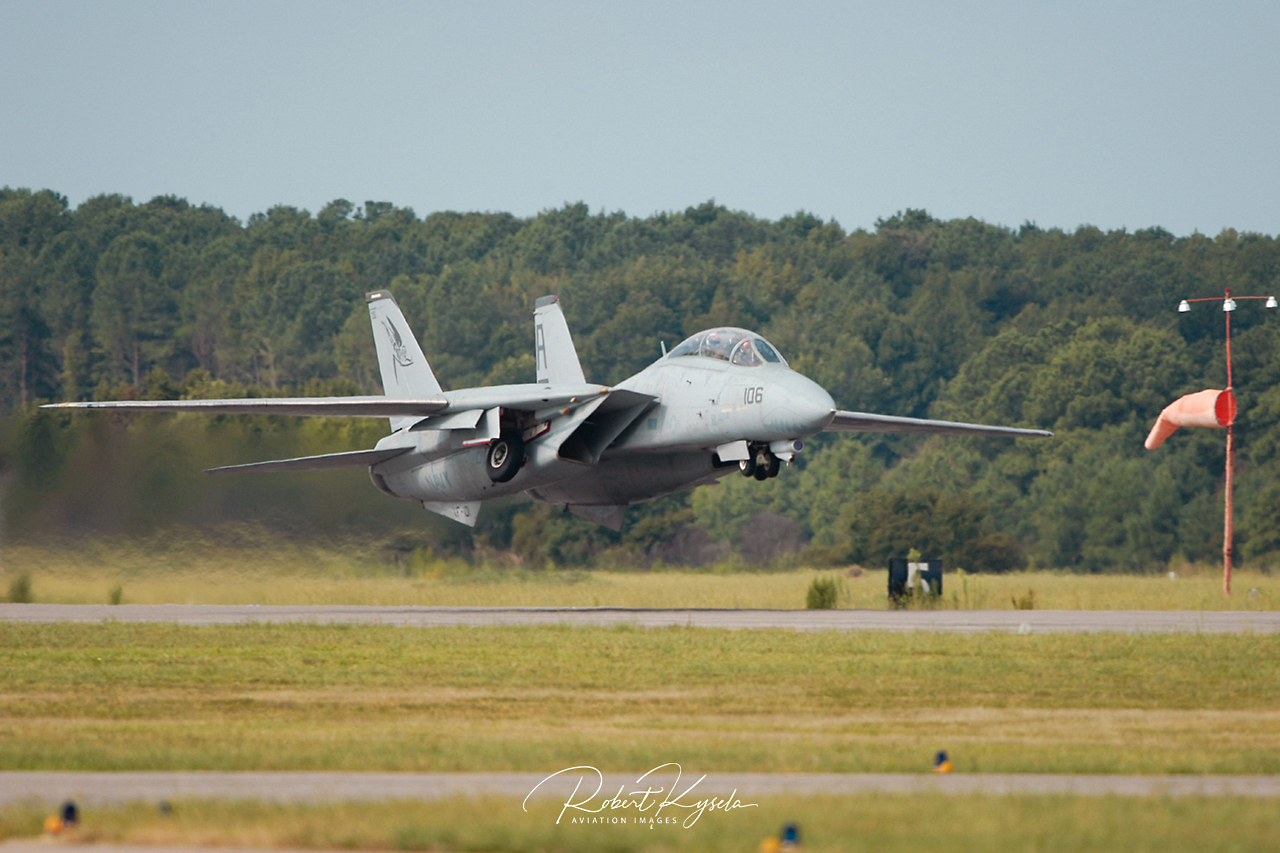
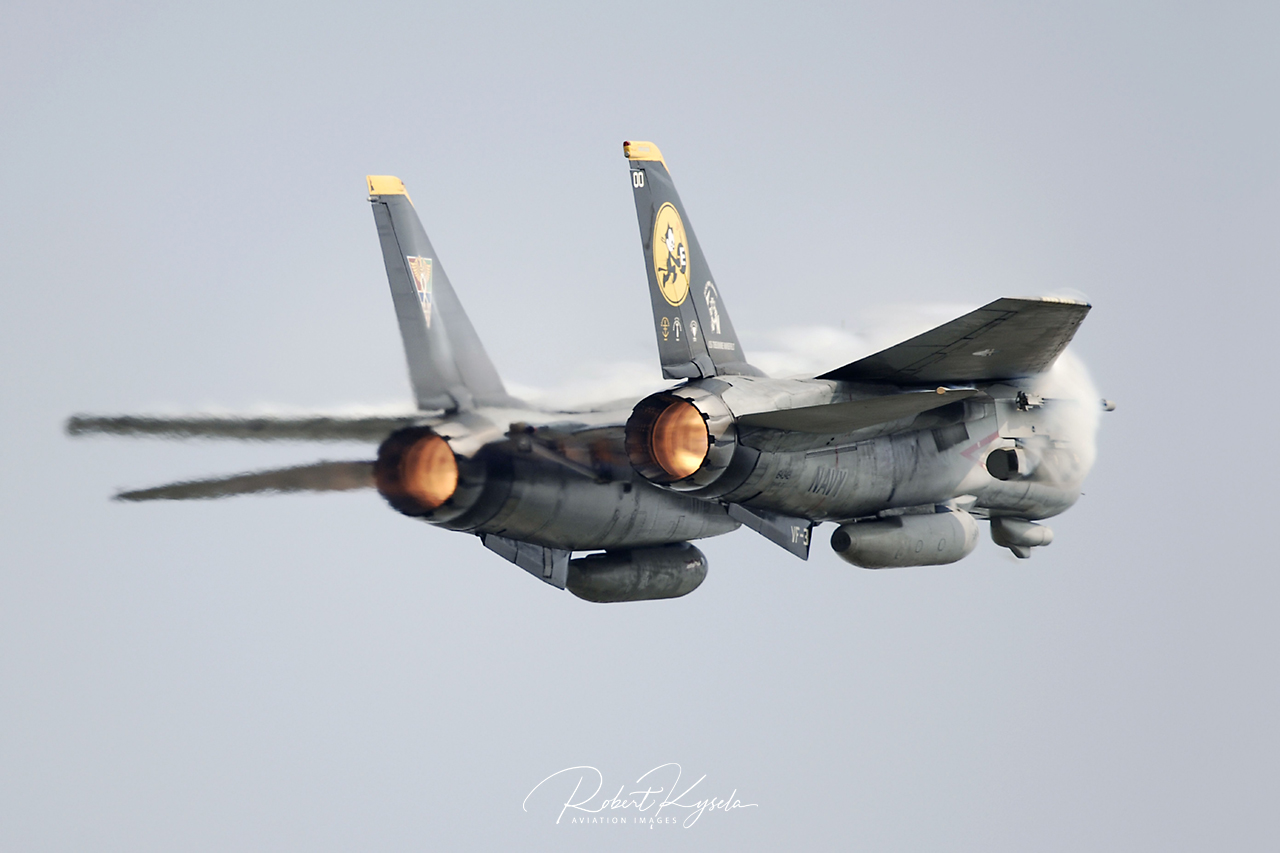
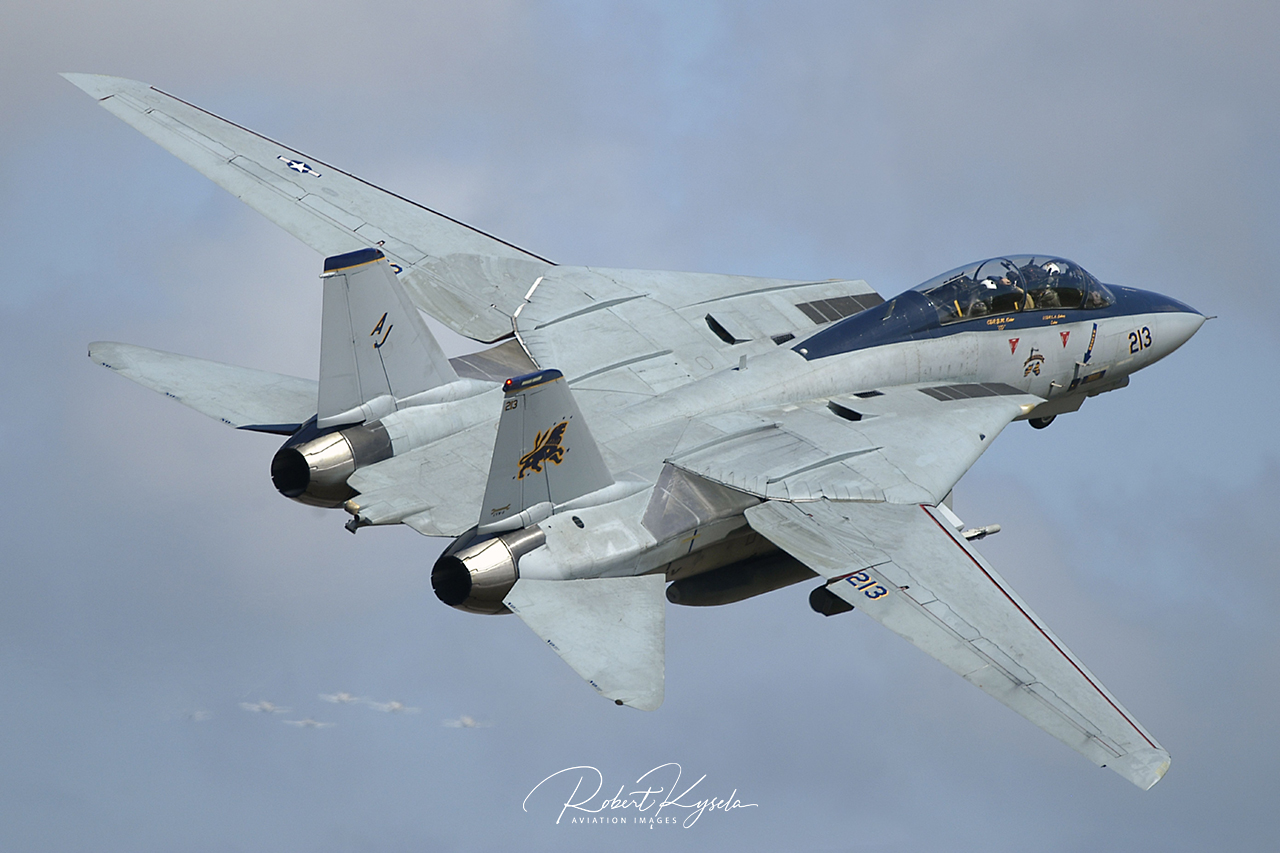
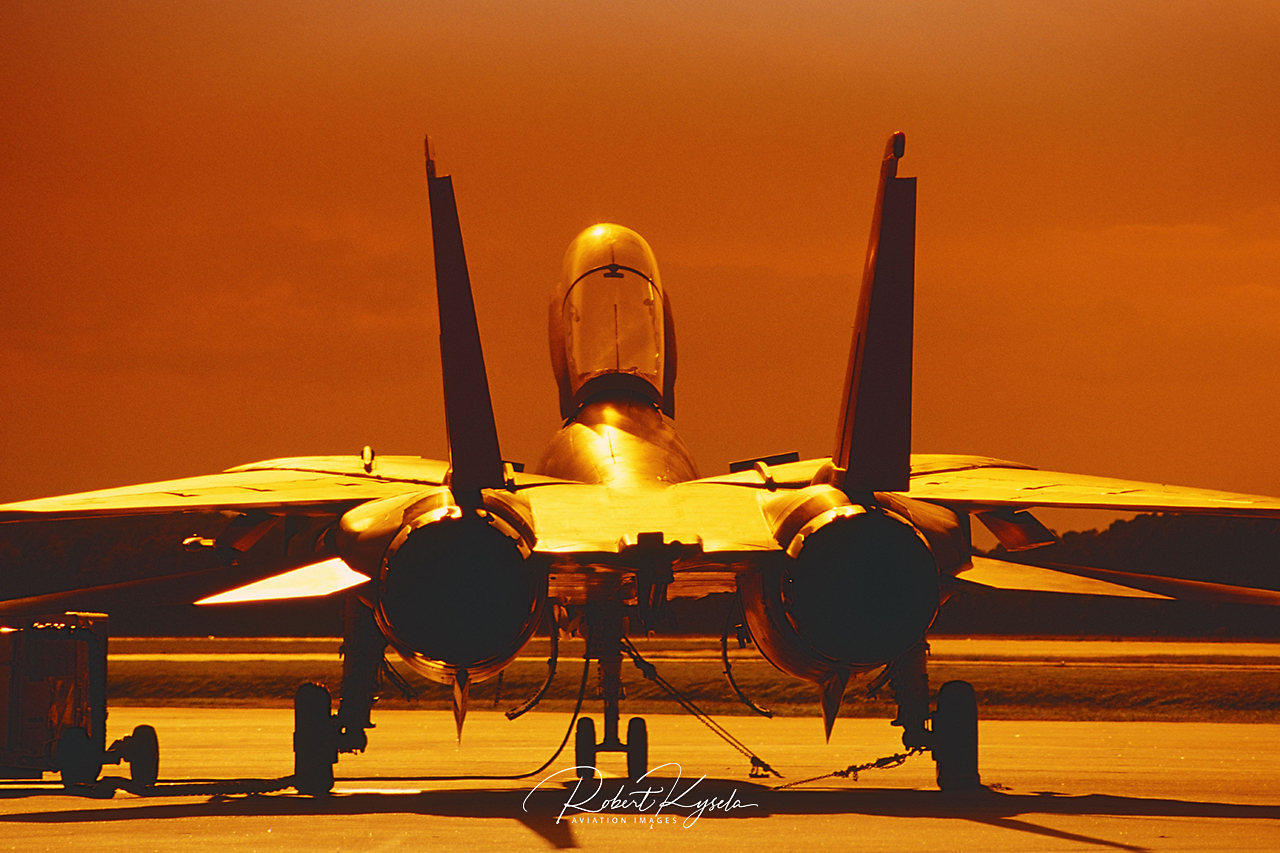
Most pilots like to classify their favourite aircraft. Fighters are commonly known as hot, and if they are good looking they are often referred to as sexy. One aircraft which fulfilled both of these criteria was one of the most famous aircraft of our time, the superlative Grumman F-14 Tomcat. For more than three decades the famous F-Fourteen was the backbone of the US Navy`s Carrier Air Groups (CAG). Few aircraft have attracted more attention or been in the public spotlight more than this famous high performance two-seat interceptor. Attributed with the downing of four Libyan fighters in the 80’s the F-14 later became the subject of Hollywood movies such as Top Gun (Tom Cruise at his best) and The Final Countdown.
On September, the 22nd 2006 the era of the Grumman F-14 Tomcat in US Navy service came to an end, which is a good reason for us to have a closer look at the very last of the Grumman Corporation’s famous navy cats.
An attempt to produce a joint navy/air force fighter in the form of the Tactical Fighter Experimental (TFX) resulted in development of the F-111 strike/fighter
R. Kysela
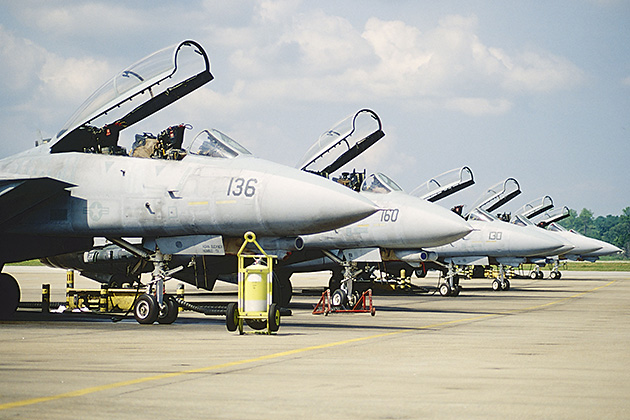
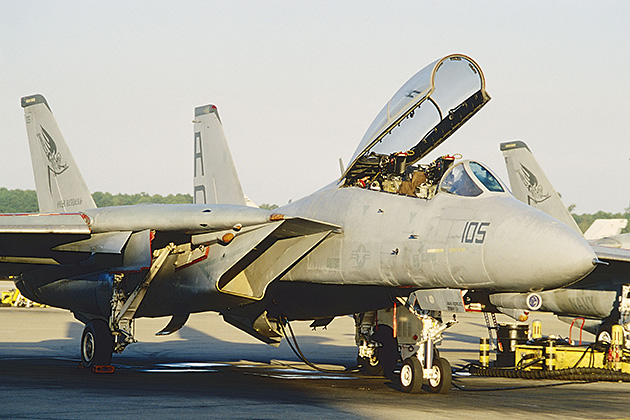
Development commenced in the 1960’s of a new subsonic high-tech, the Douglas F6D Missileer designed to carry the Bendix XAAM-N-10 “Eagle” long range Air to Air Missile (AAM) however this project was cancelled due to technical difficulties and prohibitive costs. An attempt to produce a joint navy/air force fighter in the form of the Tactical Fighter Experimental (TFX) resulted in development of the F-111 strike/fighter, however as a joint concept the project failed due to the navy B variant being much too heavy and as such too underpowered for use from an aircraft carrier and resulting in the navy withdrawing from the project. At the same time Navy officials were already looking for a replacement for their much beloved Vought F-8 Crusader and McDonnell Douglas F-4 Phantom II fighters. Following the official end of the F-111B project in 1968 the US Navy initialised a bid for the development and the construction of a new two-seat interceptor under the new designation of Navy Fighter Experimental (VFX).
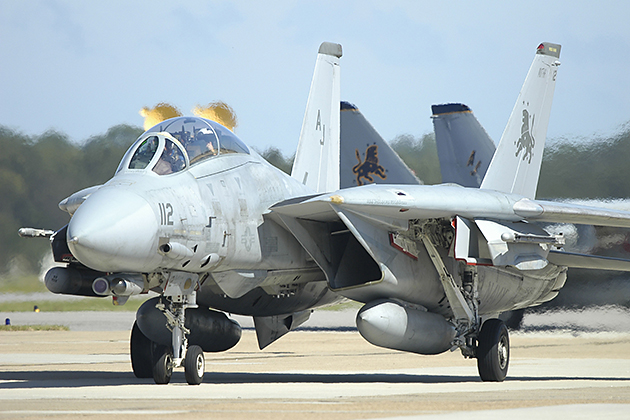
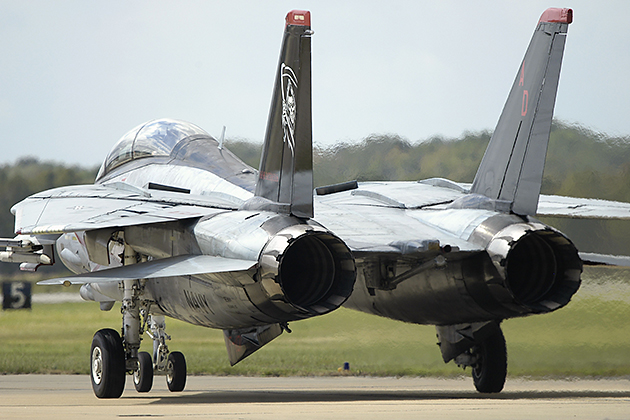
Among the various competing companies were submissions from General Dynamics, McDonnell Douglas, Ling Temco Vought and North American however it was Grumman “Ironworks” submission with their G303-E design that was accepted as the winner for the US Navy’s next generation of fighter. Designed as a tandem-seat, interceptor incorporating variable geometry wings and powered by two Pratt & Whitney TF-30 Turbofans (originally designed for the F-111) the newly designated Grumman F-14A displayed outstanding potential. Before commencing construction on the functional prototype, two wooden mock-ups were built, one incorporating a single tail unit (vertical stabiliser) however the final prototype was equipped with a twin tail unit (a significant feature of the F-14) and made its maiden flight on 21st December 1970. Contrary to its ill-fated predecessor, the F-6D Missileer, the new fighter was designed not only as a fleet defence interceptor but also as a superb dog fighter particularly against the then current and future generation of Soviet fighters, such as the MiG-21, Mig-23 and MiG-25. To fulfil this role the F-14 was equipped with a single 20mm Gatling gun on the left side of the nose and with a wide range of radar and infrared guided AAM`s, the result of the bitter lessons learnt during the Vietnam War.
Only nine days after the new fighter’s first flight the developmental prototype crashed on landing due to a catastrophic fatal hydraulic failure
R. Kysela
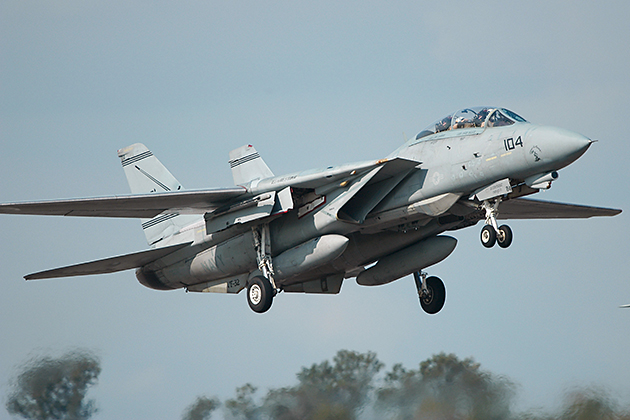
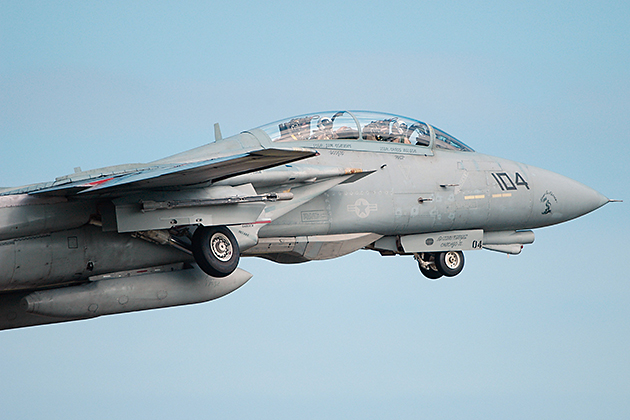
Unfortunately however, the development phase wasn’t a smooth one. Only nine days after the new fighter’s first flight the developmental prototype crashed on landing due to a catastrophic fatal hydraulic failure. Both crew members, William Millar and Robert Smythe, managed to eject at the very last minute suffering only minor injuries.Nevertheless subsequent development progressed well and only 21 months after the maiden flight the first unit, VF-124 (Gunfighters) based at Naval Air Station (NAS) Miramar received their first production aircraft. This squadron was designated a Fleet Replenishment Squadron (FRS) that was responsible for crew training and conversion to the new type. Two squadrons were allocated this task (one for each of the Atlantic and Pacific fleets), however due to bilateral disarmament initiated at the end of the cold war VF-124 was disbanded. This left VF-101 (Grim Reapers) as the only remaining training and operational conversion unit for F-14 crews. VF-101 was eventually disbanded on 30th September 2005. The first operational units to fly the Tomcat were the VF-1 (Wolf Pack) and the VF-2 (Bounty Hunters) both deployed aboard the aircraft carrier USS Enterprise (CVN-65). In the meantime the F -14 received the official name of Tomcat. Supposedly, the (unintentional) name was given by former US Navy Vice-Admiral Thomas F. Connoll who was a key campaigner against the F-111B project, the projects cancellation ultimately leading to the development of the F-14. Connoll’s call sign as a naval aviator was “Tomcat” and as all previous Grumman designs were named after cats (ie F-4F Wildcat, F-6F Hellcat, F-7F Tigercat, F-8F Bearcat) it was very fitting to continue this tradition with the F-14.
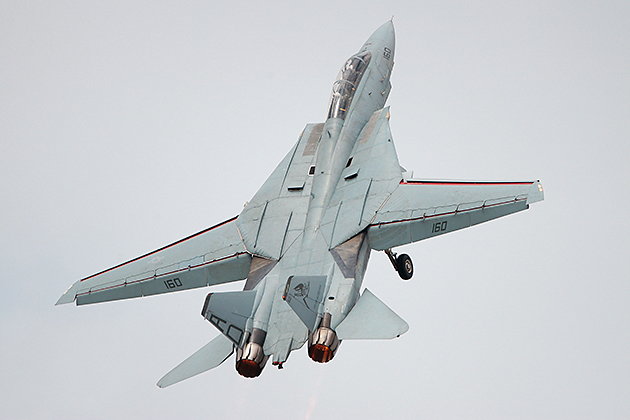
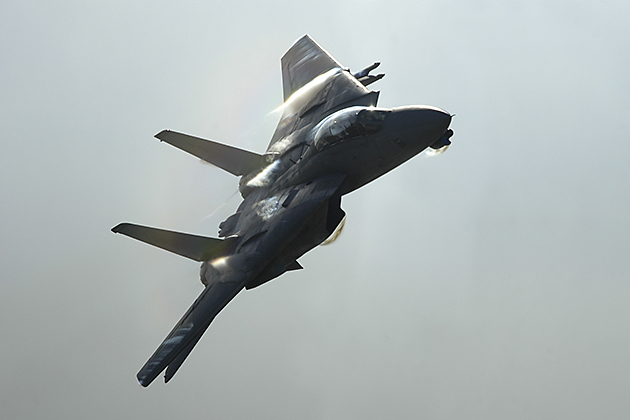
The first Tomcat squadrons saw limited action while operating from the USS Enterprise (The Big E) at the beginning of 1975 providing air cover for the evacuation of Saigon, however they failed to engage any North-Vietnamese MiG`s. Ongoing technical problems culminated in late 1975 with the loss of two F-14’s due to engine fires caused by defective turbine blades. Despite the introduction of a newer upgraded TF-30-P-414 engine, ongoing power plant problems persisted with the F-14 until it`s retirement. When flying with high angles of attack engines were capable of stalling which resulted in a complete loss of power. As such the performance of the TF-30 was far from satisfactory. For this reason Grumman engineers attempted to solve this problem by installing the new General Electric F401-PW400 engine in the F-14 airframe. Unfortunately these engines were too complex and costly resulting in the project (F-14B Super Tomcat) being cancelled. Only with the introduction of the very latest General Electric F110-GE-400 was a solution found. The F110 engine, (which in modified form also powers the Lockheed Martin F-16) is based on the F101, which was originally designed to power the Rockwell B-1B bomber.
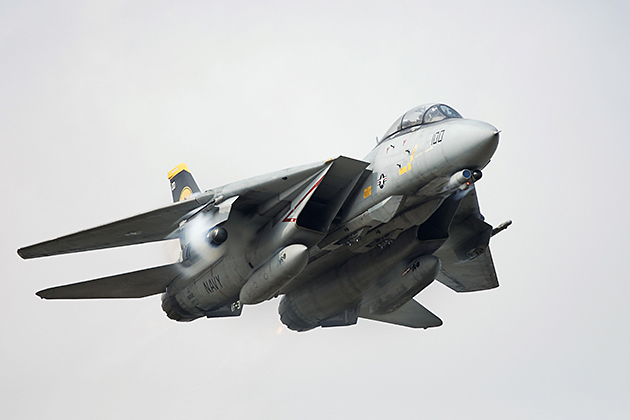
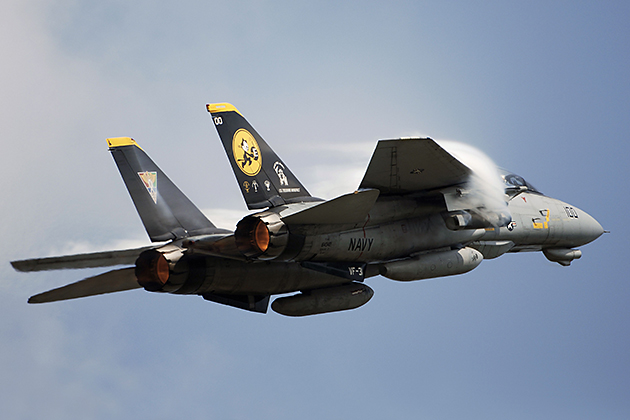
The upgraded F-Fourteen also received a new avionics suite including digital radar. As a temporary solution, until the introduction of the new D-models, several A-models were retrofitted with the new engines, Radar Warning Receivers (RWR) AN/ALR-67, advanced AN/AWG-15F Weapon Control Systems (WCS) and a fully digital engine control system. This upgraded version was initially designated as F-14+ (Plus) however later renamed the F-14B (not to be confused with the F-14B Super Tomcat). All together some 38 B models were built from new while 32 F-14A’s were converted to B standard. In comparison with the older A model the new types had greatly increased performance in almost all respects. Mission range increased by more than 62 percent while climb rate was almost three times faster than the earlier ‘A’ model. The most significant difference however was the fact that the pilot didn´t have to worry about his angle of attack and could move the throttle as fast as he wanted in both directions without worrying about engine stall. The first upgraded F-14+ made its maiden flight on 11th December 1987. The first new build aircraft flying almost a year later on 14th November 1988.
The installation of the newly developed Martin Baker Mk.14 Navy Aircrew Common Ejection Seat (NACES) ejection seat allowed the crew to eject at speeds above 1000 km/h
R. Kysela
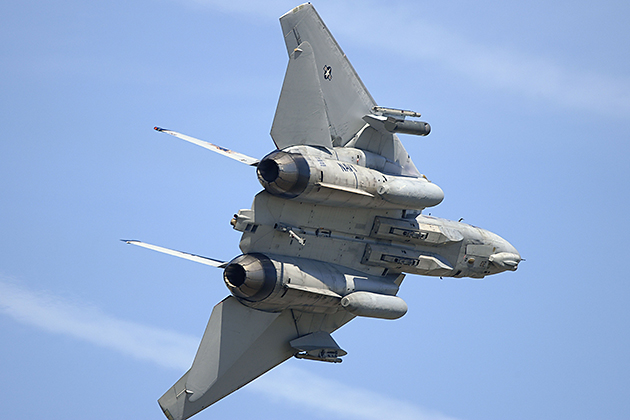
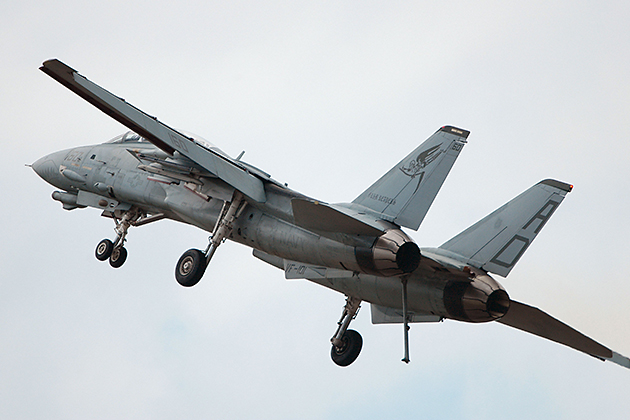
The most advanced Tomcat, the D-model was developed in parallel to the F -14B utilising an almost identical engine while the complete avionics package was digitalised (MIL-STD-1553G) and a brand new and much more powerful AN/APG-71 digital radar replaced the older analogue Hughes AN/APG-9 system. Further modifications included installation of an ASN-130 Inertial Navigation System (INS) and a General Electric Infrared Search and Track (IRST) System installed in an external container mounted under nose cone. The second container housed the Television Camera System (TCS). The installation of the newly developed Martin Baker Mk.14 Navy Aircrew Common Ejection Seat (NACES) ejection seat allowed the crew to eject at speeds above 1000 km/h. Some 127 aircraft of the advanced D-model were originally sought to be built however only 37 left the assembly line of the Grumman Corporation with production ending on 20th July 1992. A greatly changed political climate resulting in cuts in to defence spending being the primary reason. This changed climate also resulted in a merger between Grumman’s and its former competitor Northrop in May of 1994. An additional 14 A models were also converted to D model standard.
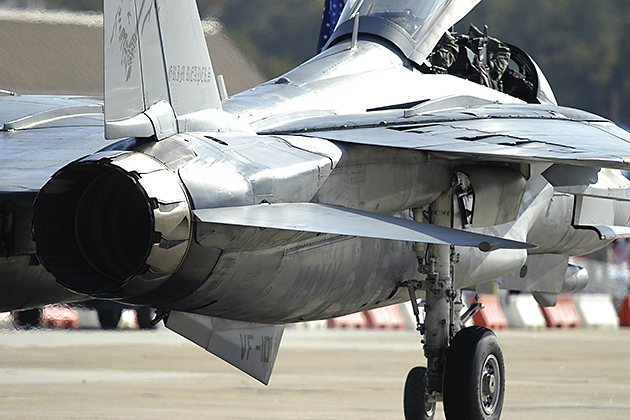
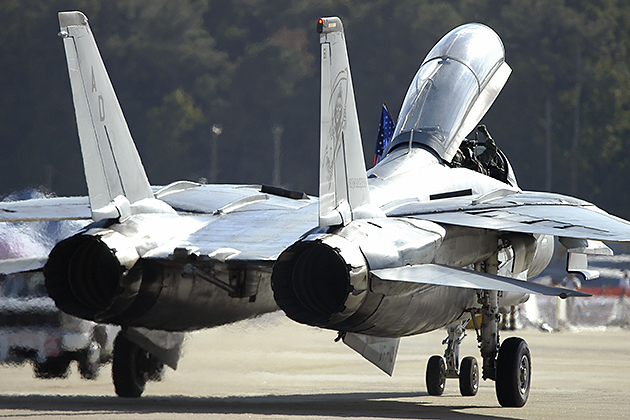
To counter the threat posed by the latest Soviet hardware such as the MiG -29 and Sukhoi Su-27 modifications were incorporated based on the F-14D. The first of these ‘Quickstrike’ modifications were based on the initiative to provide the Tomcat with the same strike capabilities as the USAF F-15E Strike Eagle. For this purpose two different Forward Looking Infra Red (FLIR ) systems were installed, one as target seeker, the other one as the target designator. Additionally the newest Air to Surface Missiles (ASM) (ie AGM-84 Harpoon or AGM-85 Maverick, etc.) could be carried on external hard points. The more ambitious Tomcat 21 featured the same avionics as Quickstrike however with the addition of fuel tanks to increase range. Even more advanced was the Attack Super Tomcat 21 (ASF-14) which was to receive the latest variant of the F110 engine (General Electric F110-GE-129) to provide greater performance in the form of a super cruise capability achieving high mach speed without using the fuel consuming use of an after burner. Even a thrust vectored controlled system was considered by Grumman engineers. Unfortunately none of these projects ever left the designers drawing boards. Because of the great potential of the Tomcats design the question must be asked if development and acquisition of the F/A-18 E/F/G Super Hornet was the most cost effective and technically viable solution.
To enforce international freedom of the seas the US Navy deployed in August 1980 two of its carriers, the USS Forrestal (CV-59) and the USS Nimitz (CVN-68) to the Mediterranean
R. Kysela
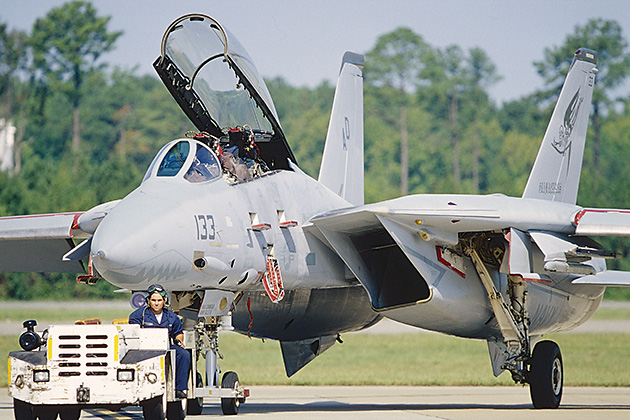
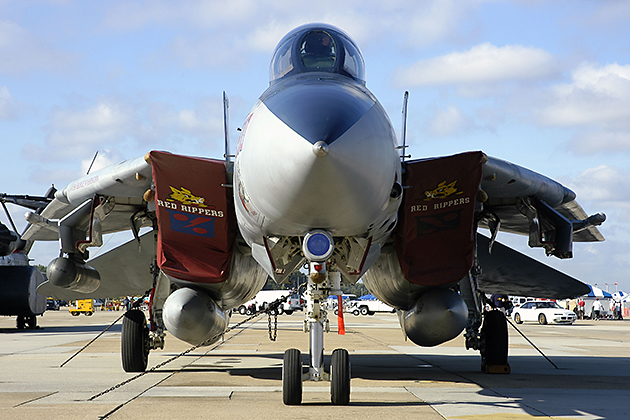
Although the F-14 took part in the final stages of the Vietnam War, it was several years until its first combat encounter with enemy aircraft. At the begin of the 1980’s tensions between the USA and Colonel Muammar Khadafy’s Libya erupted in a several clashes over the Gulf of Sidra with this area being unilaterally declared by Libya as her territorial waters in 1973. However as of 10th December 1973, in accordance with international laws sanctioned by the United Nations (UN), state coastal sovereignty was allowed to extend out to only 12 nautical miles. Previously to this the limit was established as three nautical miles only. To enforce international freedom of the seas the US Navy deployed in August 1980 two of its carriers, the USS Forrestal (CV-59) and the USS Nimitz (CVN-68) to the Mediterranean. The first encounter with Libyan jets occurred on the 19th of August 1980 when two Libyan Sukhoi Su-22 (NATO codename of Fitter) attacked a CAP (Combat Air Patrol) consisting of two Grumman F -14’s from the VF-41 (Black Aces). Both Fitters were immediately out-manoeuvred by the Tomcats and quickly shot down utilising two AIM-9L Sidewinder AAM`s. This incident not only demonstrated the Tomcat’s air superiority (while the Su-22 may be a potent ground attack aircraft it is definitely no match for an F-14), but also highlighted the beginning of a new kind of air war.
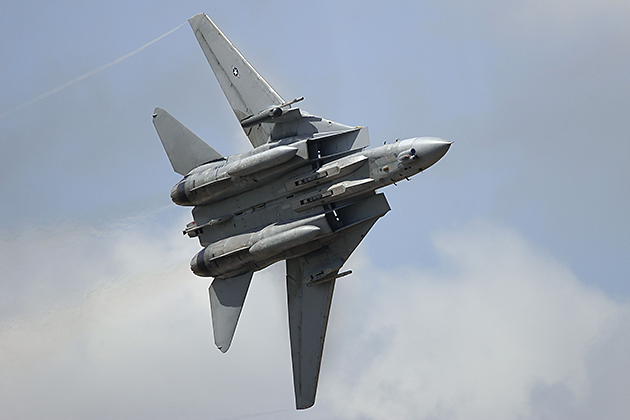
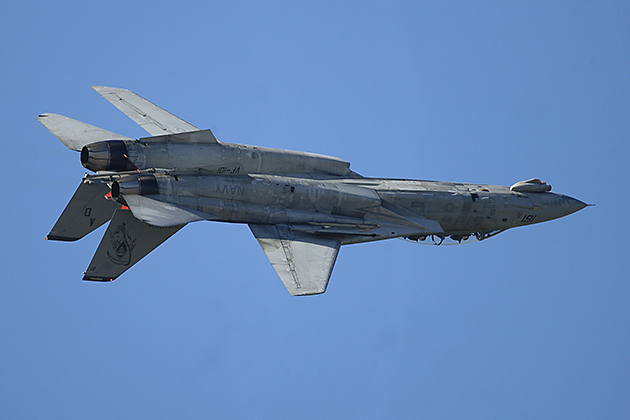
American opposition to Muammar Khadafy and his involvement in terrorist attacks was a precursor of a new kind of conflict now known as the “War on Terror”. The US carrier force equipped with the Grumman F-14 Tomcat was America’s “Big Stick”. Just a few years after the Libyan incident, in October 1985, US Tomcat`s intercepted a Egyptian Boeing 737 airliner carrying the kidnappers from the cruise liner Achilli Lauro aboard forcing it to land in Sicily. Ongoing clashes with Libya the following year resulted in the shooting down of another two Libyan aircraft, this time MiG-23’s (NATO codename of Flogger) on January, the 4th 1985. Both kills were credited to two Tomcats’ from the VF-32 (Swordsman) from the USS Kennedy. The second Gulf war in 1990/91 was not a total (public) success for the Tomcat and their crews. Fortunately however while the massive Iraqi attacks on the US carrier force everyone expected never eventuated, the recce missions flown by F-14 crews were still very dangerous. While the primary mission of the F-14’s was to protect the US fleet, various photo recce missions were also flown by a total of 99 Tomcats (from 5 different carriers) flying some 4,182 sorties. The only confirmed kill was achieved on 6th February 1991 by an F-14A from the VF-1 (Wolfpack) operating from the USS Ranger when it downed an Iraqi Mil Mi-8 (NATO codename of Hip). One of the US Navy Tomcats was also lost by ground fire and an F -14B of VF-103 (Jolly Rogers) was shot down on 21st. January 1991 over enemy territory. Both crewmembers ejected safely, one was rescued by US forces while the other was captured by the Iraqis and spend the rest of the war in captivity as a POW.
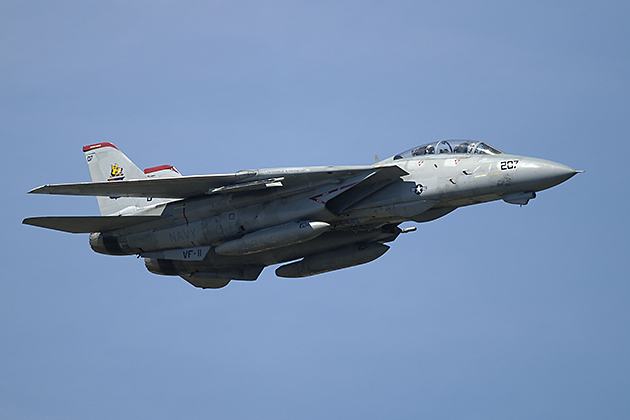
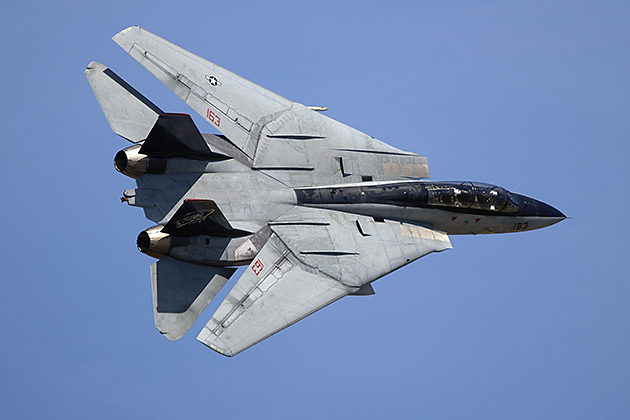
Unknown by many is the fact that Iran is the only export customer of the Grumman F-14 Tomcat. The former Iranian Shah, Shah Reza Pahlevi, ordered 80 Tomcat`s to equip the Imperial Iranian Air Force (IIAF) with the most modern weapons system of its time in an effort to counter the threat represented by Soviet Mikoyan & Gurevich MiG-25’s (NATO-codename of Foxbat), which regularly violated Iranian airspace. Until the Iranian revolution in 1978/79 resulting in the expulsion of the Shah from his country , 79 aircraft had been delivered. Of the 714 AIM-54A Phoenix missiles ordered by Iran only 284 were delivered before the American embargo went into effect. From this time on Iran was prohibited from any support for its Tomcat fleet resulting in only a few of its F-14’s being kept airworthy in the first years since the foundation of the Islamic Republic of Iran. This later improved as Iran later developed its own independent aviation industry and also because they utilised secret methods to obtain critical spare parts, some of them were even obtained via Israel from their old arch-enemy, the United States of America, a result of the infamous Iran-Contra affair. During the 1980-88 Iran – Iraq war, Iranian F-14’s were often used as an Airborne Warning and Control System (AWACS) utilising their powerful radar system. Some resources claim that Iranian F-14’s also shot down several Iraqi aircraft, nonetheless there is little evidence about the quantity and type of aircraft involved. Presently some 50 plus F-14A Tomcats are reported to be airworthy, however this also cannot be confirmed.
Compressor-stalls, short life and poor accessibility for maintenance were all issues that were only rectified by the adoption of the new General Electric F110-GE-400 Turbofan
R. Kysela
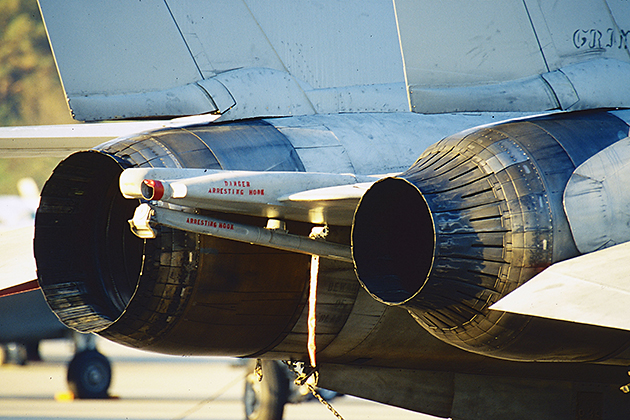
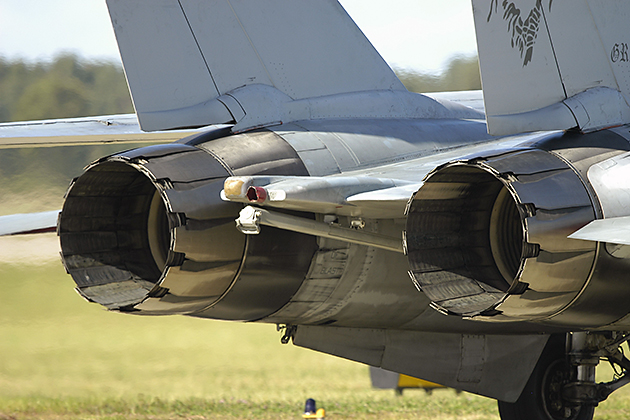
As previously mentioned, the Tomcat’s career was not a smooth one, with the TF-30 Turbofan engines in particular being problematic. Compressor-stalls, short life and poor accessibility for maintenance were all issues that were only rectified by the adoption of the new General Electric F110-GE-400 Turbofan. Several cuts in the defence budget also made it impossible to re -fit all existing F-14`s with the more reliable and much more powerful engines (120.49 kN compared to TF-30`s 93 kN). Only 46 F-14A’s were upgraded to B standard with a further 38 being newly manufactured. Additionally, 37 brand new D models were built with 18 A models converted to D configuration utilising the very powerful Hughes AN/APG-71 radar (which replaced the older AWG-9 radar system), Night Vision Goggle (NVG) compatible cockpit, search and track set, ALR-79 radar warning receiver, LCD equipped digital cockpit and last but not least installation of the brand new Zero/Zero NACES ejection seat. At the beginning of 1999 there was still some 107 F-14A, 76 F-14B and 46 F-14D still in active duty. Additionally, 9 Tomcats were also used as test beds. All together, 557 aircraft were built for the US Navy and 80 for Iran of which 79 were delivered.
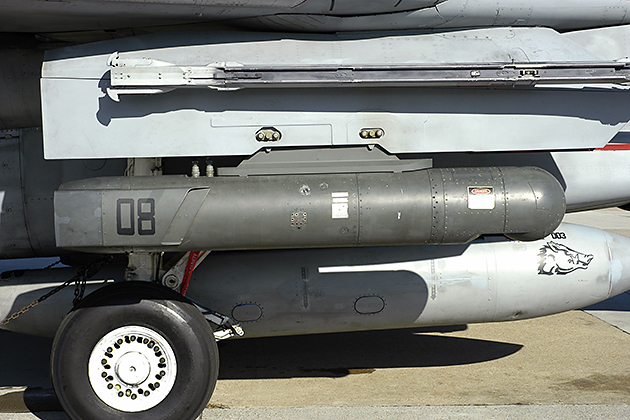
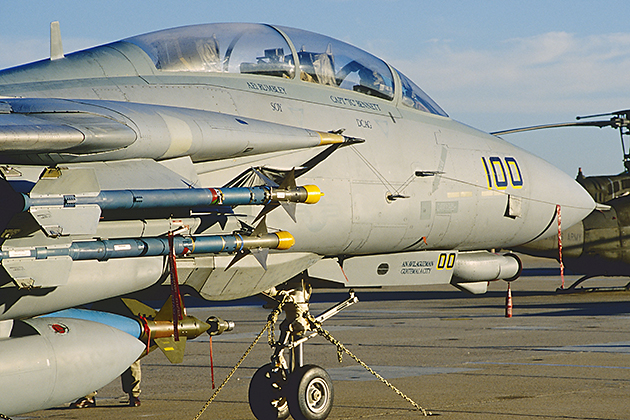
The F-14`s principal weapon system included the Hughes (later Raytheon) AIM-54 Phoenix AAM’s. This missile had a length of 3.96 m and weighted between 454 and 472 kg. Range is believed to be about approximately 110 miles. The Phoenix utilised an onboard radar system to achieve radar lock-on in its final stage of approach to target. In combination with the AN/AWG -9 Pulse/Doppler radar (especially developed for the Phoenix) Phoenix was a deadly and highly effective long range weapon system. All six AIM-54 could be independently assigned to a target and fired simultaneously (even in standard configuration a maximum of only four AIM-54 missiles carried due to the heavy weight of the weapon). The missiles warhead contained approximately 60 kg of high-explosive and was equipped with both proximity and impact fuses. Achieving a top-speed of Mach 5 plus, the AIM-54 was also capable of interception of cruise missiles and other like weapons.
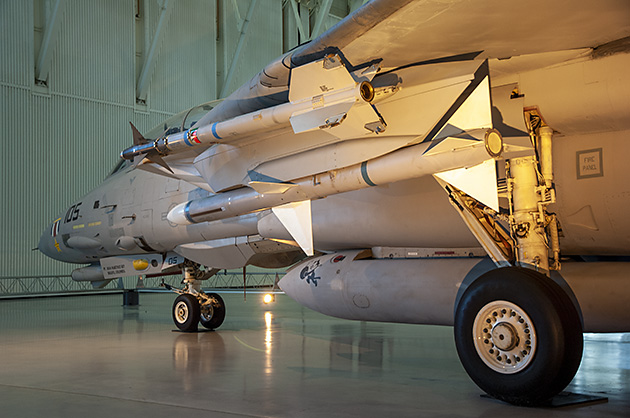
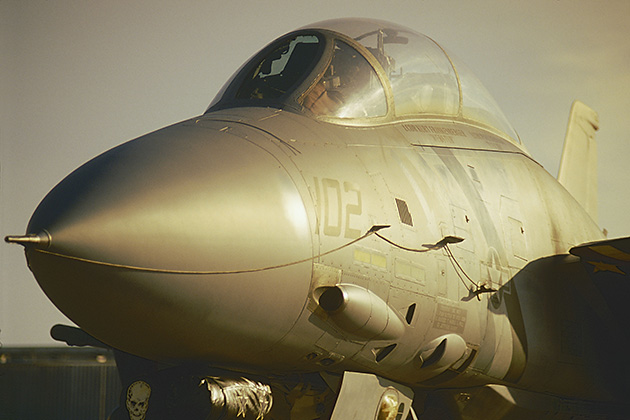
Apart from the aforementioned AIM-54 Phoenix long range missile, the F-14 also carried two AIM-9 Sidewinder Infra Red (IR) guided missiles for short range and two AIM-7 Sparrow Semi-Active Radar Homing (SARH) missiles for medium range work. For close-in air combat the Tomcat utilised a single 20mm General Electric M61A1 Vulcan Gatling type gun. Although this gun is the current de facto NATO standard weapon employed in almost all (American built) combat aircraft its penetrating power and accuracy was (and still is) of concern. Nevertheless the M61’s incredibly high fire rate at 6,000 Rounds per Minute (RPM) and the fact that it is highly reliable partially negate these concerns. The F-Fourteen was designed as a pure interceptor, a role that became less important in the 1990’s. To extend operational capability a Low Altitude Navigation and Targeting Infrared for Night (LANTIRN) pod was tested on an F-14 in 1996 which allowed the Tomcat to deploy Laser Guided Bombs (LGB) in all weather conditions. The first mission in the ground attack role was carried out in 1998 while deployed on operation Desert Fox with great success. Operational sorties were also flown in the Kosovo and Iraq as well as in Afghanistan, which highlighted the true multi–role capability of the F-14.
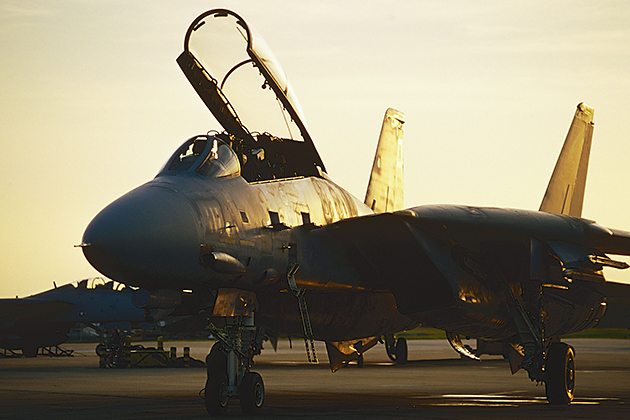
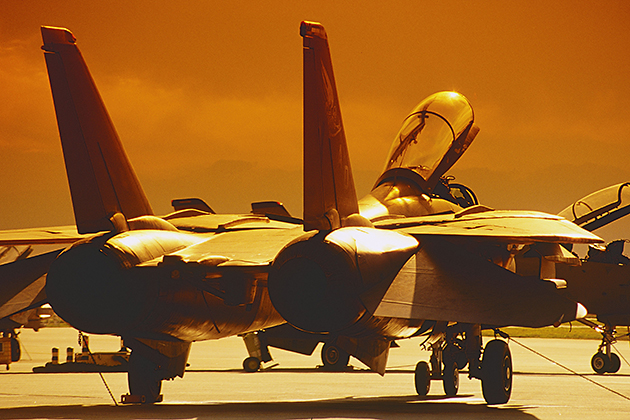
Commencing in 2002 all remaining 12 Tomcat squadrons has completed transition to the new Boeing F/A-18 E/F SUPER HORNET. Only the more capable and modern F-14B and F-14D remained in service until 2006. Although the F-14 in some aspects is still a match for its successor, the F-14 was retired sooner than originally planned. One of the main reasons for this was the increased costs of maintenance and spare parts when compared to the newer Boeing model. On 22nd September 2006 the last Grumman F -14 TOMCAT landed for the very last time at NAS Oceania as such the Islamic Republic of Iran Air Force (IRIAF) is now the only operator of the famous navy cat. For the many enthusiasts for whom the Tomcat is THE ultimate fighter the only way to see their beloved F-14 is to visit a museum, for visiting an Iranian Air Force Base (at least at the moment) is for well-known reasons not recommended or even possible.
Robert Kysela / CHK6

